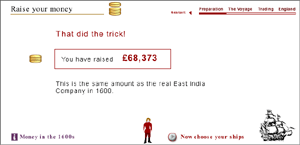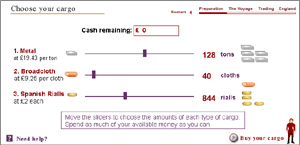|
Using the Virtual Voyage
The
Virtual Voyage is an interactive role-play
exercise, based on facts from the company's first
few voyages. We have taken the best prices and
exchange rates available from the historical record
of the early 1600s. This interactive uses these
to calculate what might have happened had the
captain of that first East India Company voyage
acted differently.
The
interactive relies on Macromedia Shockwave,
a piece of software that allows data about students'
voyages to be stored. This can be downloaded and
installed using the button on the Virtual Voyage
page. If you are planning to use this interactive
with a number of students in an IT room, make
sure that Shockwave is installed on all the machines
before the lesson as installing it can take a
little while and can sometimes be difficult if
you are on a network. Ask your IT support technician
or ICT teacher to help.
Alternatively,
you may wish to download and use the program
file version of the Virtual Voyage. Although this
requires you to download quite a large file (approx.
4.5Mb), it means you can then use the application
without being connected to the web, and without
the Shockwave plug-in. You may like to copy the
program to a number of different machines, or
use it across a school network. Click here
to download the file; when prompted, choose 'Save
the file to disk' and download it to a suitable
hard disk location. Once download is complete,
use Run from your Windows Start
button and select the downloaded file BLVV.EXE
to run the application.
Your
students can therefore take control of this voyage
and make a number of choices during the course
of the voyage that will affect the eventual outcome.
Along the way they can also divert to "fact
stops" to find out more about a particular
topic. Here is what they will face.
|
On
beginning the game students have two methods
of raising money. They will get a better
result by persuading their subscribers they
will make a profit. This makes the point
that the primary purpose of the company
from the beginning was profit, and that
making money by equal trade with other cultures
was considered of paramount importance.
The amount of money they have left (after
buying ships) will directly affect the amount
of goods they can export to the East Indies,
and therefore how much they can exchange
for in the East Indies.
|
 |
 |
There
are three types of cargo that students can
take: Iron, Broadcloth and Spanish Rialls.
Different amounts of each cargo can be gained
by moving "sliders". Only one
of these items will be valuable enough in
the East to ensure a full cargo and a healthy
profit. Which one this is can be found by
reading The
Company's Story .
|
After
setting sail, the student will be faced by one
of three perils, drawn at random by the computer.
(If they only play once, they will not see all
the different perils. This is why it is useful
for students to play the game twice, three times
or more). They will either have to:
 |
face
down a Mutiny (which teaches a lesson about
life for the crew on a ship), or |
 |
weather
a Storm (in which they could lose 10, 20 or
30% of their cargo, selected at random by
the computer), or |
 |
decide
what to do with a Portuguese Carrack (either
commit piracy or leave it in peace) |
If,
at the outset, they remembered to bring extra
provisions for their crew, the mutiny should present
no problem. They can also take advantage of James
Lancaster's insight that the feeding of lemon
juice to the crew prevented scurvy. The storm
is a matter of chance, and the student cannot
affect the outcome. The possibility of piracy
was one that was available all the time for the
early East India Company crews (although it was
generally frowned upon by the Directors in London,
especially later on). In this case, piracy is
a good way of increasing profits.
On
arrival in the East Indies, students are presented
with three exchange options. Information in The
Company's Story should give a good idea
about which of these is most likely to generate
a healthy profit. In this limited computer model,
there are no costs (in terms of crew and time)
that are incurred by visiting the Spice Islands,
but it would be useful to remind students of the
potential perils of the longer journeys. This
helps to explain why the first voyage of the East
India Company failed to make a profit.
The
computer automatically calculates a profit margin
for the student on their return to England and
offers the option of replaying the game. Since
this game can be played quite quickly, it is expected
that most students will play it more than once,
experimenting with different choices to create
different outcomes.
Prices,
and how we arrived at them
The
buying price of goods in England (iron, broadcloth
and rialls) is a matter of record. The Court Records
of the East India Company have full inventories
for the ships. Of course, the cargoes on these
ships was much more varied, but we have presented
the main ones here to keep the interactive simple.
It
is much harder to say what was (a) the exchange
value of pepper and spices to English goods when
in the East Indies and (b) the selling price of
pepper and spices in England. The reason for this
is that they varied over time, and also that there
are not complete records of selling prices. Therefore
the exchange rates and selling prices used in
this interactive have been largely extrapolated
from the profit margins on the first two voyages
wherever a definitive figure was not available.
A complication on the first voyage when it returned
in 1603 (the attempted Royal embargo on the sale
of pepper) drove the price of pepper down in relation
to its normal value. The 1603 figure has been
used, even though for other voyages the selling
price would have been higher.
|